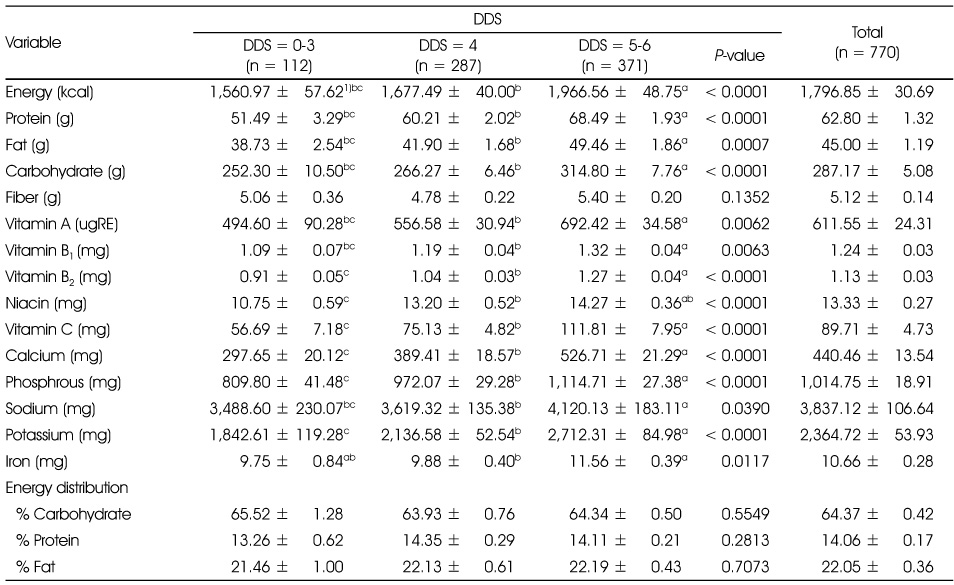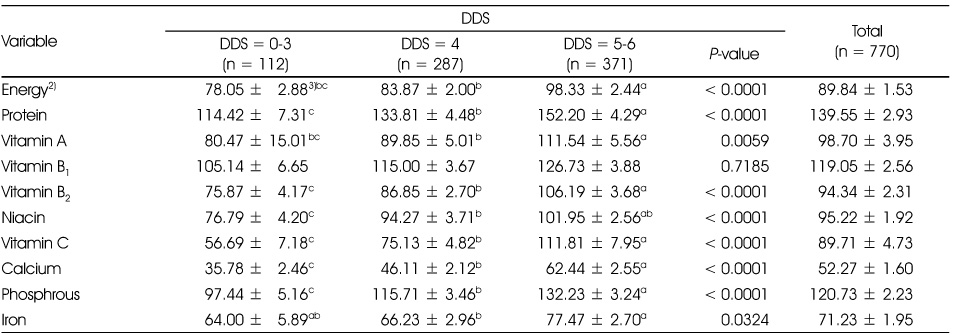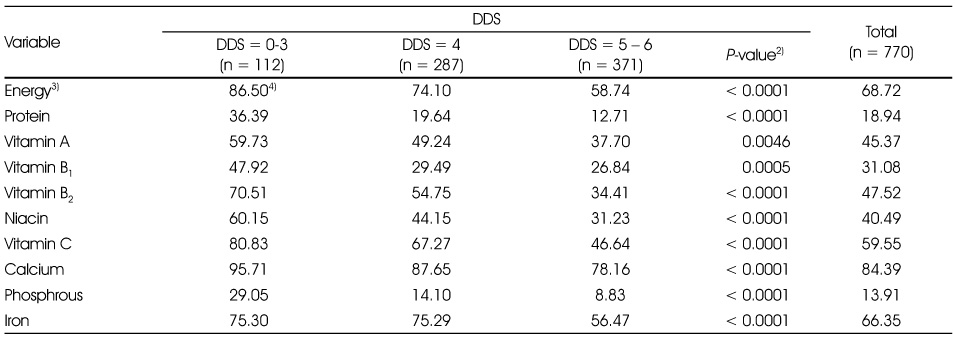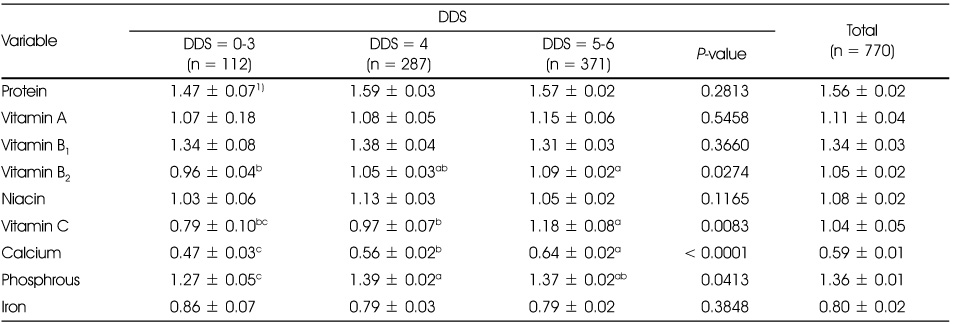Articles
- Page Path
- HOME > Korean J Community Nutr > Volume 17(4); 2012 > Article
-
Original Article
- Evaluation of Nutrient Intake and Anthropometric Parameters related to Obesity in Korean Female Adolescents according to Dietary Diversity Score: From the Korean National Health and Nutrition Examination Surveys, 2007-2009
- Yun-Jung Bae
-
Korean Journal of Community Nutrition 2012;17(4):419-428.
DOI: https://doi.org/10.5720/kjcn.2012.17.4.419
Published online: August 31, 2012
Department of Food and Nutritional Sciences, Hanbuk University, Gyeonggi, Korea.
- Corresponding author: Yun Jung Bae, Hanbuk University, 233-1 Sangpae-dong, Dongducheon-si, Gyeonggi-do 483-120, Korea. Tel: (031) 860-1445, Fax: (031) 860-1449, byj@hanbuk.ac.kr
Copyright © 2012 The Korean Society of Community Nutrition
- 347 Views
- 0 Download
- 11 Crossref
Abstract
- The purpose of this study was to evaluate nutrient intake and anthropometric parameters related to obesity in Korean female adolescents according to dietary diversity score. We analyzed data from the combined 2007-2009 Korean National Health and Nutrition Examination Survey (KNHANES). The subjects were 770 female adolescents. Nutrient intakes, Dietary Diversity Score (DDS) ) and Dietary Variety Score (DVS) were derived by using the data from the 24-recall method. The DDS was defined as the number of six food groups (cereals, meats, fruits, vegetables, dairy, fats and oils) consumed. The DVS was defined as the number of food items consumed. The average age of the subjects of the study was 15.02 years and the average height, weight, and BMI were 159.50 cm, 52.58 kg, 20.62 kg/m2, respectively. The energy and nutrients intakes, percent of the recommended intake for nutrients in DDS = 5~6 group were significantly higher than those of the other groups. Calcium and vitamin C INQ in DDS = 5~6 group were significantly higher than those of the other groups. The average DVS of the subjects was 29.33. The most frequent style of food pattern was CMDFVO (cereals, meats, dairy, fruits, vegetables, fats and oils) = 111011. In conclusion, in healthy Korean female adolescents, food diversity intake variety did beneficially affect the intakes of calcium and vitamin C. Further studies are needed to confirm these findings.
- 1. Al-Kloub MI, Al-Hassan MA, Froelicher ES. Predictors of obesity in school-aged Jordanian adolescents. Int J Nurs Pract. 2010; 16(4): 397-405.ArticlePubMed
- 2. Azadbakht L, Esmaillzadeh A. Dietary diversity score is related to obesity and abdominal adiposity among Iranian female youth. Public Health Nutr. 2011; 14(1): 62-69.ArticlePubMed
- 3. Hansen RG. An index of food quality. Nutr Rev. 1973; 31(1): 1-7.ArticlePubMed
- 4. Hansen RG, Wyse BW. Expression of nutrient allowances per 1,000 kilocalories. J Am Diet Assoc. 1980; 76(3): 223-227.ArticlePubMed
- 5. Jang HS. Evaluation of nutrient intakes and diet quality of rural middle school students. Korean J Community Nutr. 2001; 6(Suppl): 486-494.
- 6. Kant AK, Block G, Schatzkin A, Ziegler RG, Nestle M. Dietary diversity in the US population, NHANES II, 1976-1980. J Am Diet Assoc. 1991; 91(12): 1526-1531.ArticlePubMed
- 7. Kim BR, Cho YE. A study on the evaluation of food intake of middle school students in Kangneung. J Korean Soc Food Sci Nutr. 2001; 30(5): 986-999.
- 8. Kim DS, Cho Y, Cho SI, Lim IS. Body weight perception, unhealthy weight control behaviors and suicidal ideation among Korean adolescents. J Sch Health. 2009; 79(12): 585-592.ArticlePubMed
- 9. Kim HJ, Yoon JS. Food diversity and nutrient intake of elementary school students in Daegu-Kyungbook area. Korean J Community Nutr. 2010; 15(3): 297-307.
- 10. Kim IS, Yu HH, Kim YS. A study on nutrient intake, food behavior and health conditions according to food intake diversity in the elderly in a local city. Korean J Community Nutr. 2001; 6(2): 205-217.
- 11. Kim JH, Jung IK. A study on body image perception and eating disorders by gender in junior high school students in Seoul. J Korean Home Econ Assoc. 2007; 45(1): 101-109.
- 12. Kim MH, Bae YJ. Evaluation of diet quality of children and adolescents based on nutrient and food group intake and diet quality index-international (DQI-I). Korean J Community Nutr. 2010; 15(1): 1-14.
- 13. Kim O, Kim K. Body mass index, body shape satisfaction, and weight control behaviors among Korean girls. Psychol Rep. 2005; 96(3 Pt 1): 676-680.PubMed
- 14. Kim SH. A review on the relationship of milk consumption, dietary nutrient intakes and physical growth of adolescents. J Korean Dairy Technol Sci Assoc. 2010; 28(1): 9-16.
- 15. Kim SH, Kim JY, Ryu KA, Sohn CM. Evaluation of the dietary diversity and nutrient intakes in obese adults. Korean J Community Nutr. 2007; 12(5): 583-591.
- 16. Kontogianni MD, Farmaki AE, Vidra N, Sofrona S, Magkanari F, Yannakoulia M. Associations between lifestyle patterns and body mass index in a sample of Greek children and adolescents. J Am Diet Assoc. 2010; 110(2): 215-221.ArticlePubMed
- 17. Korea Centers for Disease Control and Prevention & The Korean Pediatric Society. Body growth standard values of Korean pediatrics and juveniles in 2007. 2007; Seoul.
- 18. Krebs-Smith SM, Smiciklas-Wright H, Guthrie HA, Krebs-Smith J. The effects of variety in food choices on dietary quality. J Am Diet Assoc. 1987; 87(7): 897-903.PubMed
- 19. Lee JE, Ahn Y, Kimm K, Park C. Study on the associations of dietary variety and nutrition intake level by the number of survey days. Korean J Nutr. 2004; 37(10): 908-916.
- 20. McCrory MA, Fuss PJ, McCallum JE, Yao M, Vinken AG, Hays NP, Roberts SB. Dietary variety within food groups: association with energy intake and body fatness in men and women. Am J Clin Nutr. 1999; 69(3): 440-447.PubMed
- 21. Ministry of Health and Welfare [MOHW] & Korea Center for Disease Control and Prevention [KCDCP]. Korea Health Statistics 2009: Korea National Health and Nutrition Examination Survey(KNHANES IV-3). 2010; Seoul.
- 22. Mirmiran P, Azadbakht L, Esmaillzadeh A, Azizi F. Dietary diversity score in adolescents - a good indicator of the nutritional adequacy of diets: Tehran lipid and glucose study. Asia Pac J Clin Nutr. 2004; 13(1): 56-60.PubMed
- 23. O'Dea JA, Wilson R. Socio-cognitive and nutritional factors associated with body mass index in children and adolescents: possibilities for childhood obesity prevention. Health Educ Res. 2006; 21(6): 796-805.PubMed
- 24. Ries CP, Daehler JL. Evaluation of the Nutrient Guide as a dietary assessment tool. J Am Diet Assoc. 1986; 86(2): 228-233.Article
- 25. Steyn NP, Nel JH, Nantel G, Kennedy G, Labadarios D. Food variety and dietary diversity scores in children: are they good indicators of dietary adequacy? Public Health Nutr. 2006; 9(5): 644-650.PubMed
- 26. Togo P, Osler M, Sørensen TI, Heitmann BL. Food intake patterns and body mass index in observational studies. Int J Obes Relat Metab Disord. 2001; 25(12): 1741-1751.ArticlePubMedPDF
- 27. Um JS, Park MY, Chung YJ. Composition of food groups appropriate for evaluation of diet quality of Korean adolescents-Based on Kant's minimum amount. Korean J Nutr. 2006; 39(6): 560-571.
- 28. Yim KS. Nutrient intake assessment of Korean elderly living in Inje area, according to food group intake frequency. Korean J Food Cult. 2008; 23(6): 779-792.
REFERENCES
Figure & Data
REFERENCES
Citations

- Evaluation of Dietary Nutrient Intake and Food Variety by Milk Consumption in Postmenopausal Korean Women: Data Based on the Korea National Health and Nutrition Examination Survey 2013~2015
Ae Wha Ha, Woo Kyung Kim, Sun Hyo Kim
Journal of the Korean Society of Food Science and Nutrition.2022; 51(9): 912. CrossRef - Relationship between dietary diversity score and general health in female students
Azadeh AMINIANFAR, Fereydoun SIASSI, Mostafa QORBANI, Javad KARIMI, Gity SOTOUDEH, Yas KALIKIAS, Sanaz SOLTANI
Minerva Pediatrics.2021;[Epub] CrossRef - Index of Nutritional Quality (INQ) and the Risk of Obesity in Male Adolescents: a Case-Control Study
Maryam Gholamalizadeh, Samira Rastgoo, Saeid Doaei, Farhad Vahid, Hanieh Malmir, Narges Ashoori, Alireza Mosavi Jarrahi
Biological Trace Element Research.2021; 199(5): 1701. CrossRef - Relationship between dietary intakes and the double burden of malnutrition in adults of Malang, Indonesia: An exploratory study
Soo Jin Lee, Ho Kyung Ryu
Nutrition Research and Practice.2018; 12(5): 426. CrossRef - Night eating status according to body mass index of Korean adolescents
Mi-Kyeong Choi, Yu-Jin Cho, Myung-Hee Kim, Yun Jung Bae
Nutrition & Food Science.2017; 47(1): 89. CrossRef - Systematic Review on the Study of the Childhood and Adolescent Obesity in Korea: Dietary Risk Factors
Eun Jeong Heo, Jae Eun Shim, Eun Young Yoon
Korean Journal of Community Nutrition.2017; 22(3): 191. CrossRef - Development of NQ-A, Nutrition Quotient for Korean Adolescents, to assess dietary quality and food behavior
Hye-Young Kim, Jung-Sug Lee, Ji-Yun Hwang, Sehyug Kwon, Hae Rang Chung, Tong-Kyung Kwak, Myung-Hee Kang, Young-Sun Choi
Journal of Nutrition and Health.2017; 50(2): 142. CrossRef - Comparison of Diet Quality and Diversity according to Obesity Type among 19-64 year old Korean Adults
Hyae Min Gu, So Yeon Ryu, Jong Park, Mi Ah Han, Yeong Eun Son
Korean Journal of Community Nutrition.2016; 21(6): 545. CrossRef - Effects of brown rice-vegetable school meal program on subjective health status, BMI and hematological parameters among high school students
Kyoung-Ja Moon, Hye-Young Kim
Journal of the Korea Academia-Industrial cooperation Society.2015; 16(11): 7385. CrossRef - Evaluation of the Nutritional Value of Traditional Korean Noodles through Energy Density and Diversity
YoonKyoung Yang, SungOk Kim, Juhyeon Kim
The Korean Journal of Food And Nutrition.2014; 27(4): 732. CrossRef - Effects of a Brown Rice and Vegetable Diet on the Defecation Conditions and Health Status of High School Students
Hye Young Kim
Journal of Korean Public Health Nursing.2013; 27(1): 179. CrossRef
- Figure
- We recommend
- Related articles
-
- Trends in growth and nutritional status of Korean toddlers and preschoolers: a cross-sectional study using 2010–2021 Korea National Health and Nutrition Examination Survey data
- Biochemical characteristics, nutrient intakes, and chronic disease risk according to the dietary fat energy ratio in middle-aged Korean: a cross-sectional study using data from the 7th (2016–2018) Korean National Health and Nutrition Examination Survey
- Total sugar intake and its contributed foods by age groups in Koreans using the 8th (2019–2021) Korea National Health and Nutrition Examination Survey: a cross-sectional study
- Comparative study on the health and dietary habits of Korean male and female adults before and after the coronavirus disease 2019 pandemic: utilizing data from the 8 th Korea National Health and Nutrition Examination Survey (2019–2021)

Fig. 1
General characteristics of the subjects
1) Mean ± SE (Means with different superscript letters are significantly different from each other by Tukey's test.)
All variables have been age-adjusted expect age.
Dietary intakes of the subjects
1) Mean ± SE (Means with different superscript letters are significantly different from each other by Tukey's test.)
All variables have been age-adjusted.
The percent of RNI1) of the subjects
1) Recommend Nutrient Intake
2) Estimated Energy Requirement was used
3) Mean ± SE (Means with different superscript letters are significantly different from each other by Tukey's test.)
All variables have been age-adjusted.
The percent of the subjects consumed under EAR1) of the subjects
1) Estimated Average Requirement
2) Significance as determined by χ2-test
3) Estimated Energy Requirement was used
4) %
Index of Nutritional Quality (INQ) of the subjects
1) Mean ± SE (Means with different superscript letters are significantly different from each other by Tukey's test.)
All variables have been age-adjusted.
Food intakes from each food group in subjects (g/day)
1) Mean ± SE (Means with different superscript letters are significantly different from each other by Tukey's test.)
All variables have been age-adjusted.
Distribution of food group intake pattern (CMDFVO)1) of the subjects
1) CMDFVO: cereals, meats, dairys, fruits, vegetables, fats and oils food group
1: food group(s) present, 0: food group(s) absent
For example, CMDFVO = 111111 denotes that all food group (cereals, meats, dairys, fruits, vegetables, fats and oils food group) were consumed
1) Mean ± SE (Means with different superscript letters are significantly different from each other by Tukey's test.) All variables have been age-adjusted expect age.
1) Mean ± SE (Means with different superscript letters are significantly different from each other by Tukey's test.) All variables have been age-adjusted.
1) Recommend Nutrient Intake 2) Estimated Energy Requirement was used 3) Mean ± SE (Means with different superscript letters are significantly different from each other by Tukey's test.) All variables have been age-adjusted.
1) Estimated Average Requirement 2) Significance as determined by χ2-test 3) Estimated Energy Requirement was used 4) %
1) Mean ± SE (Means with different superscript letters are significantly different from each other by Tukey's test.) All variables have been age-adjusted.
1) Mean ± SE (Means with different superscript letters are significantly different from each other by Tukey's test.) All variables have been age-adjusted.
1) CMDFVO: cereals, meats, dairys, fruits, vegetables, fats and oils food group 1: food group(s) present, 0: food group(s) absent For example, CMDFVO = 111111 denotes that all food group (cereals, meats, dairys, fruits, vegetables, fats and oils food group) were consumed

 KSCN
KSCN








 PubReader
PubReader Cite
Cite


